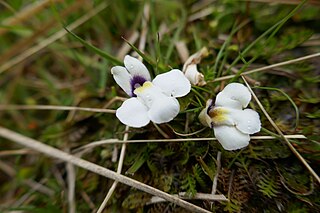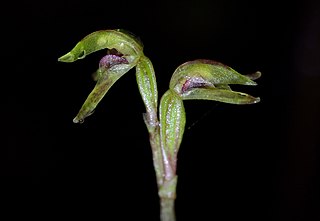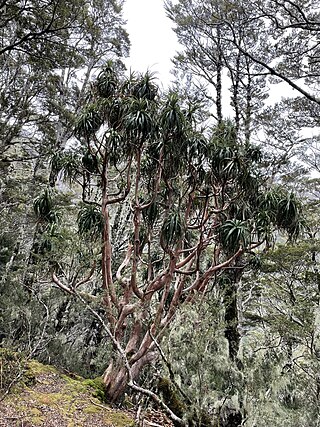
Aristotelia serrata, commonly known as wineberry or in the Māori language makomako or just mako, is a small tree in the family Elaeocarpaceae, in the genus Aristotelia, found in the North Island, South Island and Stewart Island of New Zealand.

Vitex lucens, or pūriri, is an evergreen tree endemic to New Zealand.

Asteliaceae is a family of flowering plants, placed in the order Asparagales of the monocots.

Astelia is a genus of flowering plants in the recently named family Asteliaceae. They are rhizomatous tufted perennials native to various islands in the Pacific, Indian, and South Atlantic Oceans, as well as to Australia and to the southernmost tip of South America. A significant number of the known species are endemic to New Zealand. The species generally grow in forests, swamps and amongst low alpine vegetation; occasionally they are epiphytic.

Pachystegia insignis is a species of flowering plants in the family Asteraceae. It is endemic to New Zealand.

Astelia alpina called pineapple grass, silver astelia, or perching lily is a commonly found species in alpine and subalpine areas of Tasmania and the Australian Alps. It is a perennial herb that typically dominates its environment by growing in dense clusters, called mats, in alpine bogs. There are two subspecies: Astelia alpina var. novae hollandiae from New South Wales and Victoria and Astelia alpina var. alpina endemic to Tasmania. Both subspecies appear very similar to each other. The species was originally described by Robert Brown.

Myosotis monroi is a species of flowering plant in the family Boraginaceae endemic to the South Island of New Zealand. The species was described by Thomas Cheeseman. Plants of this species of forget-me-not are perennial and erect, and have ebracteate inflorescences with cream or white corollas.

Mazus radicans, commonly known as swamp musk, is a wetland herb in the family Mazaceae, native to New Zealand.

Townsonia deflexa, commonly known as the creeping forest orchid, is a species of orchid endemic to New Zealand. It forms diffuse colonies with tiny, inconspicuous flowers and small, more or less round leaves and grows mainly in mossy places in beech forest.

Dracophyllum arboreum, commonly known as Chatham Island grass tree and tarahinau (Moriori), is a species of tree in the heath family Ericaceae. Endemic to the Chatham Islands of New Zealand, it reaches a height of 18 m (60 ft) and has leaves that differ between the juvenile and adult forms.

Dracophyllum traversii, commonly known as mountain neinei, grass tree, and pineapple tree is a species of flowering plant in the heath family Ericaceae. It is a deciduous tree endemic to New Zealand. It reaches a height of 0.2–13 m (0.66–42.65 ft) and has leaves which form tufts at the end of its branches. It has a lifespan of between 500 and 600 years.

Senecio quadridentatus is native to Australia and New Zealand. In New Zealand it is known by its Māori name pahokoraka or pekapeka. Senecio quadridentatus is an annual or perennial herbaceous flowering plant in the family Asteraceae. It is also known as Erechtites quadridentata Labill by the synonyms.

Celmisia major is a species of daisy that is endemic to New Zealand. It is split into two different varieties, Celmisia major var. major and Celmisia major var. brevis. Despite being in the same species, it is thought that the two varieties are not close to one another, with botanist Peter James de Lange stressing critical study on the taxonomy of the daisies. It was first described by Thomas Cheeseman in 1925. The major variety is found in the Auckland area and nearby islands, while the brevis variety is confined to Mount Taranaki.

Myosotis concinna is a species of flowering plant in the family Boraginaceae, endemic to the South Island of New Zealand. Thomas Cheeseman described the species in 1885. Plants of this species of forget-me-not are large, perennial rosettes which form loose tufts or clumps, with ebracteate, erect inflorescences, and yellow corollas.

Myosotis laeta is a species of flowering plant in the family Boraginaceae, endemic to ultramafic areas of the Sounds-Nelson area of the South Island of New Zealand. Thomas Cheeseman described the species in 1885. Plants of this species of forget-me-not are perennial rosettes which form loose tufts or clumps, with ebracteate, erect inflorescences, and white corollas.

Festuca matthewsii, also known as Matthew's fescue, is a species of grass in the family Poaceae. It is native to the South Island of New Zealand. It is perennial and mainly grows on subalpine or subarctic biomes. Festuca matthewsii was first described by Eduard Hackel in 1903 as Festuca ovina subsp. matthewsii, and identified as a species by Thomas Cheeseman in the posthumously released second edition of the Manual of the New Zealand Flora in 1925.

Myrsine kermadecensis, commonly known as the Kermadec matipo, Kermadec myrsine, or the Kermadec mapou, is a species of flowering plant in the family Primulaceae, edemic to the Kermadec Islands of New Zealand. It was named by Thomas Cheeseman in 1888, and first described in 1892.

Luzula traversii is a species of flowering plant in the rush, family Juncaceae. It is native to the New Zealand.

Myosotis amabilis is a species of flowering plant in the family Boraginaceae, endemic to New Zealand. Thomas Cheeseman described the species in 1906 based on specimens collected at Mt Hikurangi. Plants of this species of forget-me-not are perennial rosettes with ebracteate inflorescences and white corollas with stamens that are exserted.

Myosotis angustata is a species of flowering plant in the family Boraginaceae, endemic to the South Island of New Zealand. Thomas Cheeseman described the species in 1906. Plants of this species of forget-me-not are perennial rosettes with ebracteate inflorescences and white corollas with stamens that are wholly exserted.





















